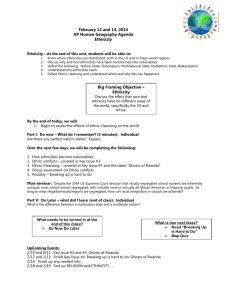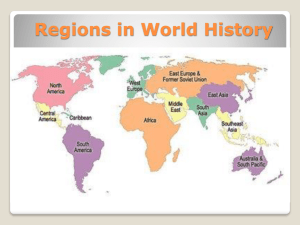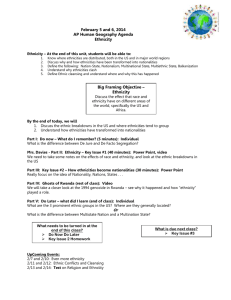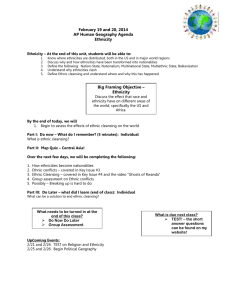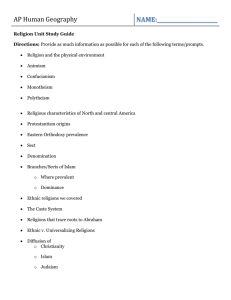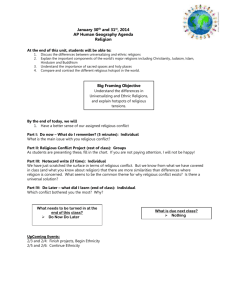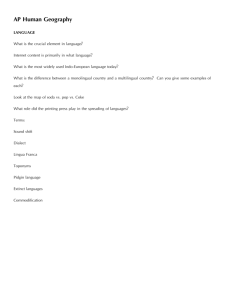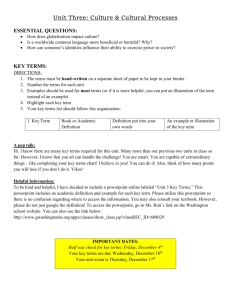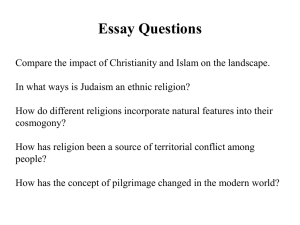February 3 and 4, 2014 AP Human Geography Agenda Religion
advertisement
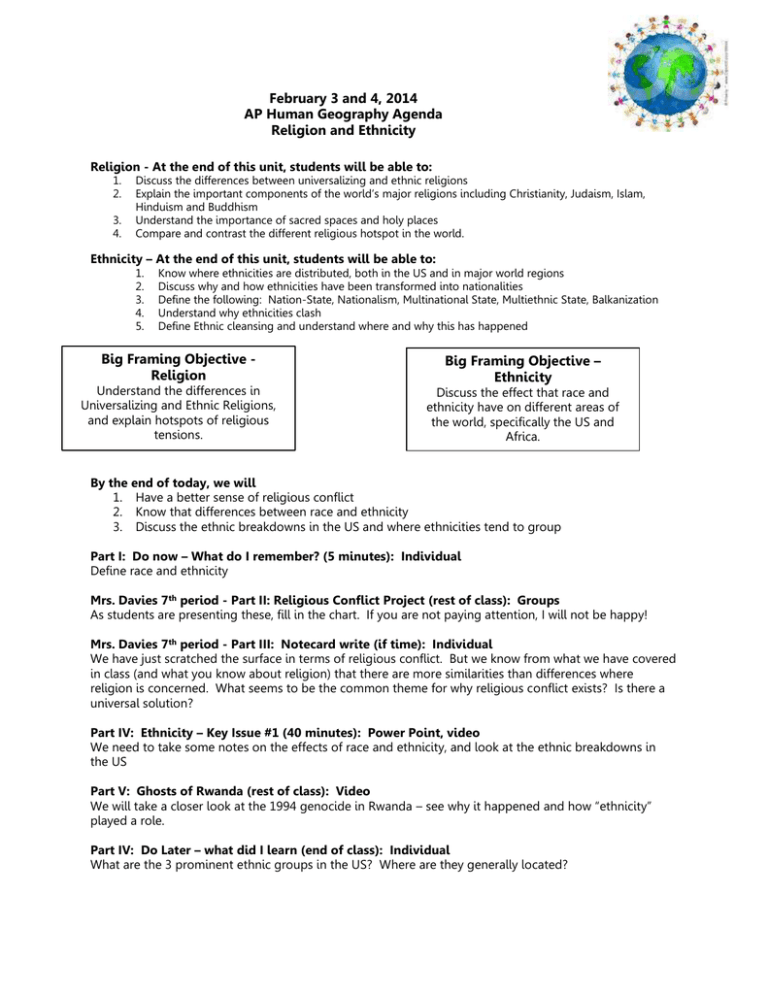
February 3 and 4, 2014 AP Human Geography Agenda Religion and Ethnicity Religion - At the end of this unit, students will be able to: 1. 2. 3. 4. Discuss the differences between universalizing and ethnic religions Explain the important components of the world’s major religions including Christianity, Judaism, Islam, Hinduism and Buddhism Understand the importance of sacred spaces and holy places Compare and contrast the different religious hotspot in the world. Ethnicity – At the end of this unit, students will be able to: 1. 2. 3. 4. 5. Know where ethnicities are distributed, both in the US and in major world regions Discuss why and how ethnicities have been transformed into nationalities Define the following: Nation-State, Nationalism, Multinational State, Multiethnic State, Balkanization Understand why ethnicities clash Define Ethnic cleansing and understand where and why this has happened Big Framing Objective Religion Understand the differences in Universalizing and Ethnic Religions, and explain hotspots of religious tensions. Big Framing Objective – Ethnicity Discuss the effect that race and ethnicity have on different areas of the world, specifically the US and Africa. By the end of today, we will 1. Have a better sense of religious conflict 2. Know that differences between race and ethnicity 3. Discuss the ethnic breakdowns in the US and where ethnicities tend to group Part I: Do now – What do I remember? (5 minutes): Individual Define race and ethnicity Mrs. Davies 7th period - Part II: Religious Conflict Project (rest of class): Groups As students are presenting these, fill in the chart. If you are not paying attention, I will not be happy! Mrs. Davies 7th period - Part III: Notecard write (if time): Individual We have just scratched the surface in terms of religious conflict. But we know from what we have covered in class (and what you know about religion) that there are more similarities than differences where religion is concerned. What seems to be the common theme for why religious conflict exists? Is there a universal solution? Part IV: Ethnicity – Key Issue #1 (40 minutes): Power Point, video We need to take some notes on the effects of race and ethnicity, and look at the ethnic breakdowns in the US Part V: Ghosts of Rwanda (rest of class): Video We will take a closer look at the 1994 genocide in Rwanda – see why it happened and how “ethnicity” played a role. Part IV: Do Later – what did I learn (end of class): Individual What are the 3 prominent ethnic groups in the US? Where are they generally located? What needs to be turned in at the end of this class? Do Now Do Later What is due next class? Key Issue 2 UpComing Events: 2/5 and 2/6: Continue Ethnicity 2/7 and 2/10: Even more ethnicity IF YOU LEARN ONLY 3 THINGS IN THIS UNIT: 1. 2. 3. There are 5 primary relgions in the world today: Christianity, Islam, Judaism (the 3 “western” religions) and Hinduism and Buddhism (the 2 “eastern” religions). Christianity is the largest religion in the world with just over 2 billion followers. Islam is the fastest growing religion in the world. Religions are defined as monotheistic or polytheistic, and ethnic (born into) or universalizing (may convert into). There are architectual differences in religious structures around the world. Christians use churches, Jews use synagogues, Muslims use mosques, Hindus use temples, and Buddhist use pagodas. This Day in History 1468 Johann Gutenberg, German printer and inventor, died. 1870 1913 1917 1959 1995 1998 The 15th Amendment (black suffrage) passed. The 16th Amendment, establishing federal income tax, was ratified. The U.S. broke off diplomatic relations with Germany. Rock singers, Buddy Holly, Richie Valens, and Big Bopper died in a plane crash. Col. Eileen Collins became the first woman to pilot the space shuttle when the Discovery blasted off. Texas executed Karla Faye Tucker, the first woman to be executed in the United States since 1984. INTERFAITH CONFLICTS Place China (Tibet) Nigeria Interfaith Boundary Tibetan Buddhism and Atheism Islam and Christianity India Hinduism and Sikhism India and Pakistan Former Yugoslavia Hinduism and Islam Central African Republic Muslim and Christianity Christianity and Islam Conflict The atheist Chinese government id destroying Tibetan Buddhist monasteries, and overall trying to suppress the religion. Islam prevails in the northern region while Christianity and local religions prevail in the South. Lead to power based tensions for government control Sikhs in the NW state of Punjab demand autonomy from the Hinducontrolled government of India Pakistan was established as a Muslim state in 1948. Pakistan and India are fighting over territory called Jammu and Kashmir In the Yugoslavian civil wars of the 1990s, Serb leader Slobadan Milosevic tried to kill or evict the Muslim population in Bosnia and the other Serbian controlled lands in the region With its Muslim-Christian overtones risks escalating into sustained violence along religious lines and spilling beyond the country’s Burma/Myanmar Buddhism and Islam borders, further destabilizing the whole region Though Muslims nationwide have been targeted, members of one particular ethnic group, the Rohingya, have borne the brunt of the violence. Many Buddhists view the Rohingya Muslims, who live along the border with Bangladesh, as illegal immigrants, even though many have been in Myanmar for generations. INTRAFAITH CONFLICTS Place Iraq Intrafaith Boundary Islam: Sunni and Shiite US Christian: Fundamentalism and moderate Christianity Christian: Protestant and Catholic Northern Ireland Conflict After the fall of the largely Sunni government controlled by Saddam Hussein, both Sunnis and Shiites are warring for control of the newly forming political landscape Christians have conflicted in the US over political-cultural issues such as homosexuality, evolution, and abortion. In some cases, violent tactics have been used British Colonialism deposited large numbers of Protestants in traditionally Catholic Northern Ireland. Has caused violent conflicts between the 2 groups in the regions

